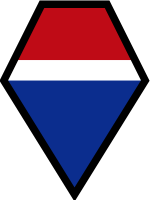|
Twelfth United States Army Group
The Twelfth United States Army Group was the largest and most powerful United States Army formation ever to take to the field, commanding four field armies at its peak in 1945: First United States Army, Third United States Army, Ninth United States Army, and Fifteenth United States Army.[1] The order of battle across the four armies comprised 12 corps, containing a total of 48 divisions. Formed eight days after the Normandy landings, it initially controlled the First and the Third US Armies. Through various configurations in 1944 and 1945, the Twelfth US Army Group controlled the majority of American forces on the Western Front. It was commanded by General Omar Bradley with its headquarters established in London on 14 July 1944. During the first week of the Normandy landings and the Battle of Normandy, Bradley's First US Army formed the right wing of the Allied lines. They were joined during July by the Third US Army, under the command of General George S. Patton, to form the Twelfth Army Group. Twelfth Army Group became operational in France on 1 August 1944. With General Omar Bradley assuming command of the Twelfth Army Group, Lieutenant General Courtney Hodges assumed command of the First Army. In addition, the USAAF's Ninth Air Force (not included in the 1.3 million soldiers figure) was attached to support the field armies of the Twelfth Army Group.[2] Until 1 September 1944, when General Dwight D. Eisenhower assumed overall command of the Allied land forces in Northwest Europe, the US forces in Normandy were included with the British Second Army and the First Canadian Army in the British headquarters formation 21st Army Group, commanded by General Bernard Montgomery. After the breakout from the beach-head at Normandy, the Twelfth Army Group formed the center of the Allied forces on the Western Front. To the north was the British 21st Army Group (the First Canadian and British Second) and, to the south, advancing from their landing on the Mediterranean coast, was the Sixth United States Army Group (Seventh United States Army and French First Army). As the Twelfth advanced through Germany in 1945, it grew to control four United States field armies: the First, the Third, the Ninth and the Fifteenth. By V-E Day, the Twelfth Army Group was a force that numbered over 1.3 million men.[3] Twelfth Army Group was inactivated on 12 July 1945 upon Bradley's departure to become Director of the Veterans Administration. Its subordinate elements then became directly subordinate to United States Army Europe. Staff
Order of battle – 8 May 1945
Source: Bradley, Omar, A Soldier's Story, New York: Henry Holt and Company (1950), pp. 557–561 References and notes
External links
|
|||||||||||||||||||||||||||||||||||||||||||||||||||||||||||||||||||||||||||||||||||||||||||||||||||||||||||||||

